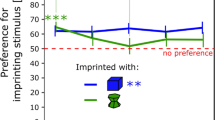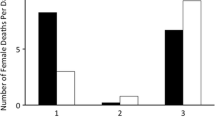Abstract
Salzen’s (1962) neuronal model hypothesis of imprinting was tested using white peking ducklings and live hens with no previous maternal experiences as stimulus objects. One model was an adult white peking duck, and the other model was an adult rouen duck. The subjects were reared with their models for 24 hr. and tested for their preferences. They were then reared for an additional 24 hr. with the other model and again tested. The results indicated that the subjects reared with the rouen duck would not alter their initial preference. Subjects reared with the white peking model reversed their initial preference, but not to a statistically significant degree. The results do not completely support Salzen’s hypothesis.
Similar content being viewed by others
Reference Notes
SHAPIRO, L. J. 1970. The effect of various durations of enforced exposure to a stimulus object on the reversibility of the following response in white peking ducklings. Unpublished doctoral dissertation, Texas Christian University.
SHAPIRO, L. J. 1968. Imprinting’s critical period: Critical or periodic? Unpublished master’s thesis, Texas Christian University.
References
GOTTLIEB, G. 1971. Development of species identification in birds. Chicago: University of Chicago Press.
KEAR, J. 1965. The internal food reserves of hatching mallard ducklings. Journal of Wildlife Management, 29, 523–528.
MYERS, J. L. 1966. Fundamentals of experimental design. Boston: Allyn & Bacon.
SALZEN, E. A. 1962. Imprinting and fear. Symposium of the Zoological Society of London, 8, 199–217.
SALZEN, E. A., & MEYER, C. C. 1967. Imprinting: Reversal of a preference established during the critical period. Nature, 215, 785–786.
SALZEN, E. A., & MEYER, C. C. 1968. Reversibility of imprinting. Journal of Comparative white peking ducklings. Bulletin of Psychonomic Society, 5, 140–142.
SHAPIRO, L. J. 1970. Automation and experimental control in a laboratory for imprinting research. Journal of Comparative and Physiological Psychology, 73, 421–426.
SHAPIRO, L. J. 1977. Developing preferences for live female models of the same or other species in white peking ducklings. Animal Behaviour, 25, 849–858.
SHAPIRO, L. J., & AGNEW, R. L. 1975. The development of preferences for live models in white peking ducklings. Bulletin of the Psychonomic Society, 5, 140–142.
Author information
Authors and Affiliations
Additional information
This publication represents Contribution No. 1 from the Avian Behaviour Laboratory. Portions of this article were presented at the March, 1972 meeting of the Southern Society for Philosophy and Psychology, St. Louis, Missouri. This article was supported by funds from Grants 431-1665-09 and 431-1665-10 from the University of Manitoba Research Board.
Rights and permissions
About this article
Cite this article
Shapiro, L.J., Thurston, K.G. The Effect of Enforced Exposure to Live Models on The Reversibility of Attachments in White Peking Ducklings. Psychol Rec 28, 479–485 (1978). https://doi.org/10.1007/BF03394560
Published:
Issue Date:
DOI: https://doi.org/10.1007/BF03394560




